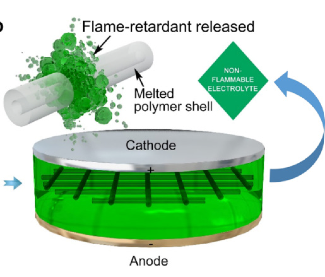Thermal-triggered Flame-retardant separator for Lithium-ion Batteries
Kai Liu
Replace this text with author’s affiliation;Tsinghua University, y Beijing, Beijing, 100083, China
EXTENDED ABSTRACT: Although the energy densities of the batteries continue to increase, the safety problems, for example, fires and explosions associated with the highly flammable liquid organic electrolytes remains a big issue that has greatly hindered their further practical applications, especially for the next generation of high energy batteries. Generally, people add flame-retardant additives into the electrolytes to reduce the risk of fire and explosions, which, however, will significantly deteriorates the electrochemical performance of lithium ion batteries. To solve this problem, we fabricated a novel “smart” non-woven electrospun with thermal triggered flame-retardant properties for lithium ion batteries. The encapsulation of flame-retardant inside a protective polymer shell has prevented direct dissolution of the retardant agent into the electrolyte, which would otherwise cause negative effects to the battery performance. During thermal run-away of the lithium ion battery, the protective polymer shell would be melted triggered by the increased temperature and the flame-retardant would be released, thus effectively suppressing the combustion of the highly flammable electrolytes. With this smart and adaptive material in the battery, we don’t have to make a trade-off between the electrolyte nonflammability and electrochemical performances of the battery. Moreover, the fabrication of the flame-retardant separator is facile and straightforward, which makes it promising for scaling up.

Figure 1. Schematic showing the smart separator.
REFERENCES
[1] K. Liu, Y. Cui* et al. Science Advances, 2017, 3, e1601978.
[2] K. Liu, Y. Cui* et al. Science Advances, 2018, 4, eaas9820.
[3] K. Liu, Y. Cui* et al. Joule, 2018, 2, 1857.
[4] K. Liu, Y. Cui* et al. J. Am. Chem. Soc. 2017, 139, 4815.

Kai Liu has completed his PhD at the age of 27 years from Tsinghua University and Postdoctoral Studies from Materials Science and Engineering, Stanford University, US. He is the now an Assistant Professor of Tsinghua University. He has published 18 first/corresponding-authored papers, including Science Advances, Adv. Mater., JACS, Angew Chem etc, which has been highlighted by Science,Nature Materials,NPG Asia Materials, CNN, BBC etc. He has won some awards including the prestigious Dinitris N. Chorafas Young Investigator Award.